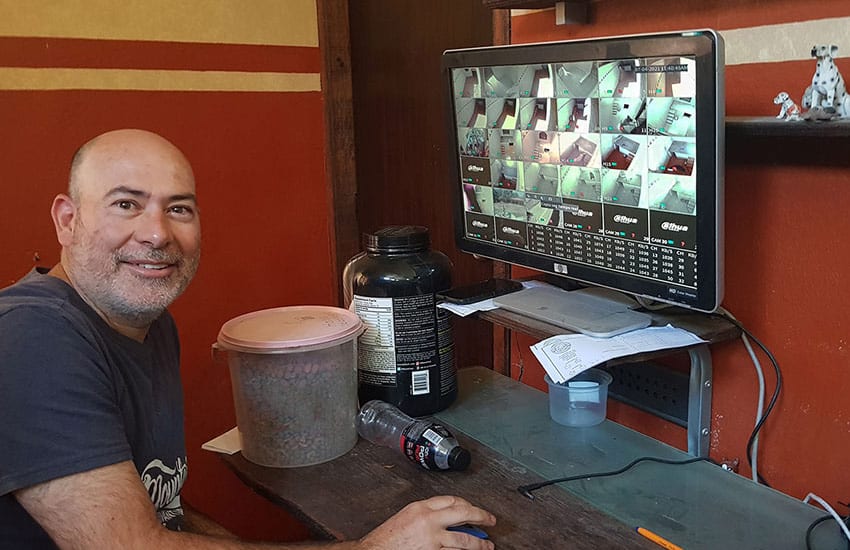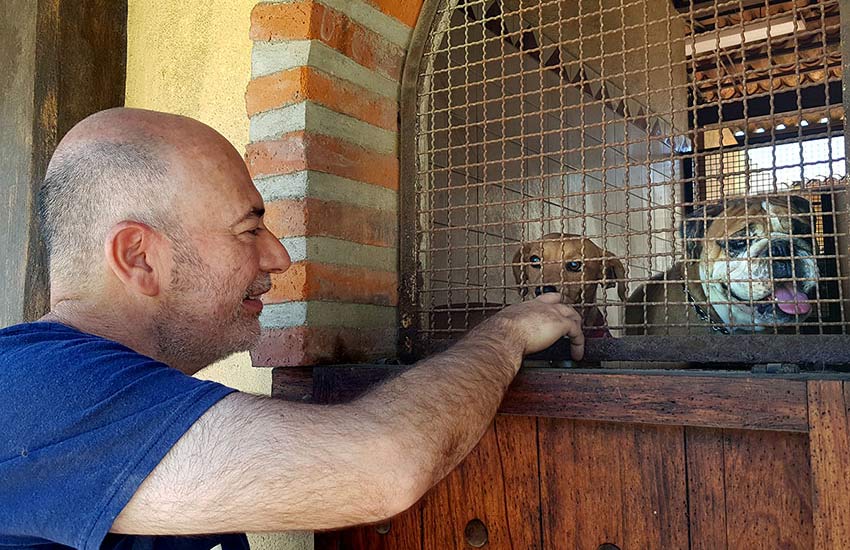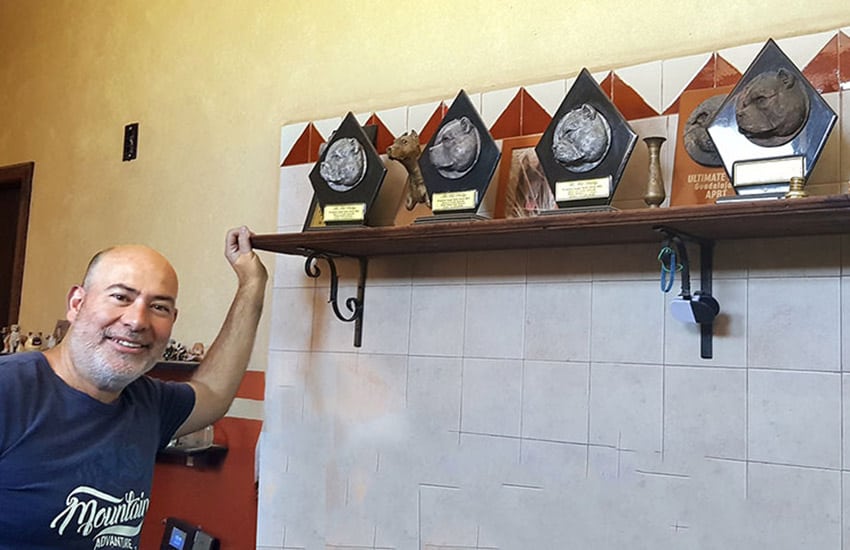“Birds fly, bears growl and dogs bark. That’s how things are!”
This seems to be the favorite refrain of dog owners in Mexico when neighbors complain about the noise.
I may tend to believe it in regards to birds and bears, but when it comes to dogs my mind immediately goes back to many, many delightful episodes of the TV series The Dog Whisperer, where I sat in open-eyed wonder watching Mexican-born César Millán perform what truly seemed like miracles, over and over. The mild-mannered, unflappable Leader of the Pack would knock on a door, and when it opened we would be introduced to the meanest four-legged monster that ever trampled upon the surface of the earth. Then we would meet the dog’s owners: trembling, distraught and frequently bleeding from their ogre’s latest love bite.
César would simply smile and, explaining that this dog was just “out of balance,” would then make an unexpected little sound like psst! — which had the most extraordinary effect upon the poor creature. By the end of the show, the unbalanced monster had turned into a perfectly normal, well-behaved pet, its owners staring in wide-eyed amazement and gratitude at the wonderful change.
“So why does my community sound like a dog pound every night?” I asked myself. “And why have my friends and I all received dog bites? Haven’t my neighbors learned the power of a psst?”

When I mentioned all this to my friend Paul, he said, “Don’t you know we have our own dog whisperer right here in the neighborhood? Last year, I was going off to Europe for a few weeks, so I left my dog Charlie — who was very young and undisciplined and overly frisky — at Hacienda La Venta Club Canino, which is a very nice dog hotel. They told me they also did dog training. When I came back, Charlie had been transformed. He would heel, he would sit, he would lie down when he was told to, he would come when he was told to, he would wait for me outside the house — and I like the way the trainer Memo did it: using rewards, not punishments.”
One day, I decided to check out Club Canino, located in the town of La Venta del Astillero, a 10-minute drive west of Guadalajara and just a five-minute walk from the community where I live.
Behind a big gate I found a beautiful, wide, grass-covered patio surrounded by hacienda-like arches. All the dogs’ rooms face the patio, and each room has a window so that the guests can keep an eye on everything that’s going on outside. Besides that, each suite has a closed-circuit camera so that the owner can keep an eye on the dog via smartphone.
The founder and director of this inviting place, Guillermo Ortiz, sat me down in a nice shady spot at the edge of the patio. When Memo, as he calls himself, told me he had been working with dogs all his life, I asked him how canines look at the world.
“Basically, the dog sees the world through his nose. It’s through his sense of smell that a dog knows if you are afraid, if you are sad, if you are happy,” he said. “Each of us is a chemical factory, and we are constantly giving off hormones according to our estado de ánimo, our mood. All of this the dog perceives, so he is able to read us much better than we are able to read him.
“Dogs have been at man’s side for more than 30,000 years, plenty of time for them to figure out exactly what we are expressing, even if we ourselves don’t know. As for us humans, we aren’t nearly as good at reading dogs … but we can learn. We can observe their facial expressions, their vocalizations, the position of their tail, their posture, their body language. And with all this, we can hope to understand their inner state. Are my dog’s ears erect, relaxed, pointing forward, pointing back? All of these things we can learn to read.”

I asked Memo to tell me something about training dogs.
“Some dogs are aggressive. People have brought us different breeds. For example, pit bulls and bull terriers can have this problem. Here we’ve had very good results, and it’s not unusual to change their behavior 100%. Whatever the case, we’ve always seen an improvement,” he said.
“Every dog is different. We have to look carefully at each particular case before deciding what techniques to use for each dog, but in general, it’s important to give a dog confidence, to let him know that what we want from him is a friendly relation with other dogs, that nothing bad will happen to him if he does what we are asking. In extreme cases, it’s important to draw their attention every single time a situation arises and to reward them whenever they accept the presence of another dog. The corrections we use are always in the language that they understand. We don’t hit dogs or mistreat them. We use the technique that the dog’s mother used when it was a puppy, to touch the dog in certain places, to put it into a position of submission, everything within the language of canine psychology.
“Here’s an example: once we had a dog named Kida with a problem. She was a pit bull, and she fought with every dog she saw until her owner reached the point where she simply couldn’t take Kida outside at all. Kida’s rehabilitation took about one month, and at the end, her owner could take her for a walk anywhere, passing other dogs with no problem. The case of another American Pit Bull Terrier named Bruno — who had been used in dog fights — was much more severe. Bruno needed four months to learn to tolerate other dogs.”
I asked Memo if he also did home visits.
“Yes, we offer classes at people’s homes. The class lasts 45 minutes, but it’s not for the dog, it’s for the owner, so they learn how to manage their dog. Most problems caused by dogs are actually being provoked by their owners.

“We also give classes here at our installation. When it comes to more difficult cases, the dog stays here with us for as long as necessary. Every time the owner comes to visit the dogs, we explain the advances we’ve seen and eventually the dog goes back to its home.”
Finally, I brought up the subject of barking. “Can anything be done about it?”
“Here we offer training for dogs with problems of conduct or with traumas,” he said. “The problem of excessive barking is usually due to excessive energy or boredom, and we can use certain techniques to reduce the noise. We may not always achieve 100% success, but we usually see at least a 50% to 60% improvement.
“I’m thinking, for example, of a German Shepherd named Luna. The owners lived in Villa Real, and the problem was that Luna barked all day long and never stopped. So we worked with her, and the result is that today she barks only occasionally, like any normal dog.”
“What did you do to bring about this change?” I asked.
“It’s simple: exercise, training and the help of a special collar that produces a vibration when the dog barks. The training includes positive reinforcement every time the dog stays quiet for a while. When this happens you reward her, you pet her and you take her out to play, so she relates food and walks with keeping quiet. A lot of dogs bark because they want attention. What we have to do is convince them of the opposite: keeping quiet will get them what they want. As for the electronic collar, you can find it in specialized stores or you can get it from Mercado Libre.”
After meeting Memo the dog trainer and watching several reruns of The Dog Whisperer, I now walk the cobblestone streets of my fraccionamiento (neighborhood) understanding that the cacophony of barking all around me comes from countless dogs who are stressed and unbalanced because their owners have made them that way.
Club Canino has 24 roomy “suites” where you can leave your dog when you’re on vacation. It also features a training path where you can practice heeling, climbing stairs, etc. For more information, see their Facebook page or call Memo Ortiz at 333 140 8268.
The writer has lived near Guadalajara, Jalisco, for 31 years and is the author of A Guide to West Mexico’s Guachimontones and Surrounding Area and co-author of Outdoors in Western Mexico. More of his writing can be found on his website.
